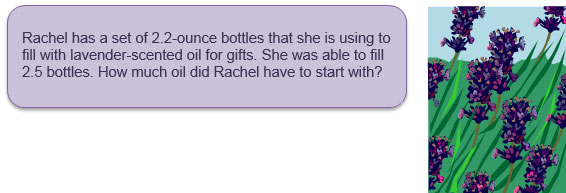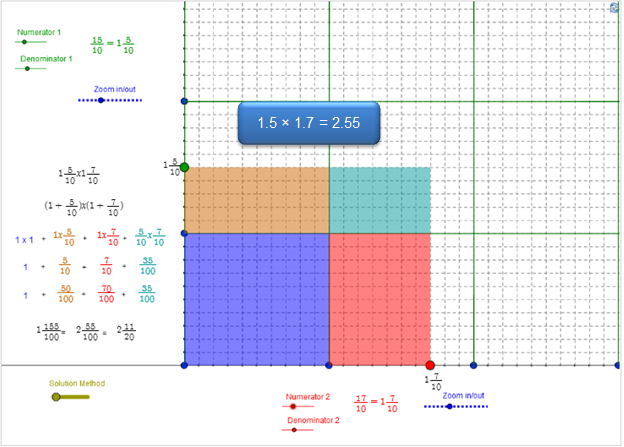
Now that you’ve investigated addition and subtraction with decimals and fractions, let’s take a closer look at multiplication and division. You will start in this section with decimals, and then use a similar model to multiply and divide fractions and mixed numbers in the next section.
Consider the following problem.

Interactive popup. Assistance may be required.
2.2 × 2.5

Interactive popup. Assistance may be required.
Anu multiplied 22 and 25 as though there were no decimal point present. Then, she noticed that each factor has 1 digit to the right of the decimal for a total of 2 digits to the right of the decimal. This information told Anu that the product must also have 2 digits to the right of the decimal, so she knew her product would be 5.50.
Interactive popup. Assistance may be required.
2.2 is 22 over 10 2 10 , which is the same as 22 over 10 22 10 .
![]() The interactive below uses blocks to multiply decimals. When the blocks are combined, they will form a rectangle; the area of the rectangle is the product of the two decimals or the answer to Rachel’s problem.
The interactive below uses blocks to multiply decimals. When the blocks are combined, they will form a rectangle; the area of the rectangle is the product of the two decimals or the answer to Rachel’s problem.
The  represents 1 unit, the
represents 1 unit, the  represents one tenth of a unit (0.1), and the
represents one tenth of a unit (0.1), and the  represents one hundredth of a unit (0.01).
represents one hundredth of a unit (0.01).
Interactive popup. Assistance may be required.
Yes, it is still 5.5 ounces.
Interactive popup. Assistance may be required.


Based on what you saw in the interactive, why do you think that the product has the same number of digits to the right of the decimal as the total number of digits to the right of the decimal in the two factors?

Interactive popup. Assistance may be required.
Set up and solve a multiplication problem.
Interactive popup. Assistance may be required.
Since this question is asking you to determine a rate, use division.
Interactive popup. Assistance may be required.
Since this question is asking you to determine a rate, use division.
Interactive popup. Assistance may be required.
Determine how far Breanna and Brian have traveled downward, and then determine their new elevation.